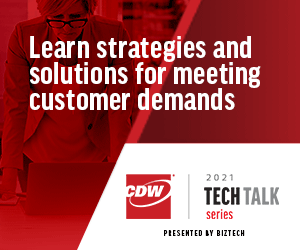With regard to agility, companies are wondering how they can adapt quickly to changing customer demands. DeCoster said they’re asking, “How do I harness all of the customer data that’s out there? How do I quickly translate that into new application features so that I can respond to the customer needs immediately?”
Risk is a major concern for many organizations right now, and DeCoster said they’re considering how to secure the perimeter, especially when it’s being redefined in an increasingly distributed world.
Finally, companies are concerned about their customers and the experience they’re being provided. “How do we engage our customers digitally, and how do we make sure that we impress them at every digital touchpoint?” DeCoster said.
Innovative Tech Choices Can Provide a Competitive Edge
DeCoster pointed out that “COVID has really changed what it means to be present: present at the workplace, present in the classroom, presence with customers. All of that is different now.”
“This really relates to how customers go about modernizing their applications, and specifically how they go from having a monolithic application architecture to one that is microservices-based, or container-based, or services-based,” DeCoster said. “Because then, with that modernized approach, they are able to start taking advantage of all the cloud-native capabilities, things like analytics and AI, ML, and data visualization, and the data pipeline.”
Companies that had already invested in innovative technologies have been at an advantage throughout the pandemic, DeCoster said. “They are absolutely taking share from other competitors during COVID because they know exactly how the customer is going to behave online. They know what they’re going to buy, what they’re not going to buy, and they can take those analytics and channel that right back into their application to create this better customer experience.”
Innovative Tools Also Raise Questions Around Security and Infrastructure
DeCoster acknowledged that implementing new technologies can also raise security concerns. The first step is building a solid infrastructure.
He said the ideal infrastructure is one that allows an organization to rapidly scale, enable continuous integration and delivery of their applications, leverage all the data at their disposal, and secure it at the same time.
“Customers have some fundamental questions to answer about their infrastructure,” DeCoster said. They must decide in financial terms how they want to consume infrastructure, and they must decide on a platform for managing it. “Where are they on their platform journey? Are they cloud-first? What are they going to do with their existing infrastructure in their data center or in their hosting facility? Is the application suite that they have container-based? In a sense, infrastructure doesn’t matter, and they can seamlessly move data and applications from one part of infrastructure to another.”
Finally, DeCoster said, organizations must decide what their corporate initiatives are. “Are they digital-first? Are they zero-trust security? Whether the infrastructure ends up being on-premises, hybrid cloud, multicloud, public cloud — that's great, as long as it can rapidly scale, support continuous integration and continuous delivery for the applications, and can leverage and secure their customer data,” he said.













